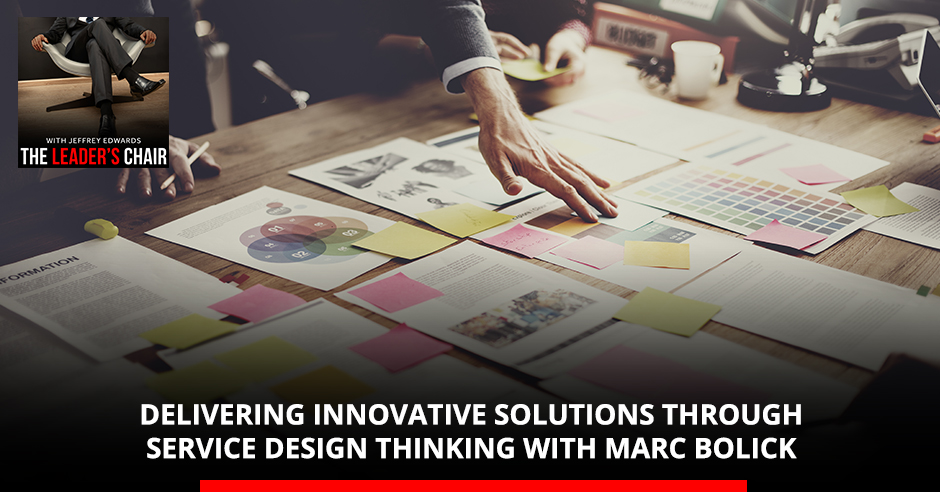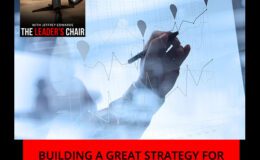
Although a popular concept, design thinking is still somewhat of a mystery to a lot of people. It’s defined as an iterative process that teams use to understand users, challenge assumptions, redefine problems, and create innovative solutions to prototype and test.
To shed more light on this process, I spoke to design thinker and entrepreneur Marc Bolick.
About Marc Bolick
 Marc Bolick leads the US office of DesignThinkers Group. With over 20 years of experience in product and service creation, Marc has worked in a variety of sectors including medical devices, mobile and web applications, travel and leisure, financial services, and innovation consulting.
Marc Bolick leads the US office of DesignThinkers Group. With over 20 years of experience in product and service creation, Marc has worked in a variety of sectors including medical devices, mobile and web applications, travel and leisure, financial services, and innovation consulting.
He is an engaging strategic thinker, behaviour observer and group facilitator. Marc is also a passionate practitioner of design thinking and service design methodologies, and he loves balancing both left and right brain approaches to solving problems.
Check out this episode if you want to learn more about:
- What strategic design looks like in action
- How to develop a design mindset
- Why humility and vulnerability are key to business success
🎧 Listen to the podcast here:
Delivering Innovative Solutions Through Service Design Thinking With Marc Bolick
We’re in the middle of a pandemic and yet, here we are talking about strategic design! What is strategic design – how does it relate to leadership?
We’ve all had different experiences of leadership as citizens and fellow humans in our various different communities. We also have another crisis that’s emerging, and I think it would be totally wrong of us not to mention what we’re experiencing in the United States.
It’s a wave going across the world — the issues of inclusion, diversity, the crisis and tragedies that we’ve had in our communities with policing, to say the least. As a white man of white privilege, I want to acknowledge that, because that’s also another area where we need creative solutions, and we need leadership. Both of those areas are equal crises that we’re facing. The issue of race, inequality and justice is something that’s unfortunately cross-cutting. Hopefully, leadership will show up for that.
Marc, I appreciate your comments and also your insights. Leadership is a part of everything that we do, in all parts of our lives and communities. The same principles of design also apply to the solutions we create for our communities on a long-term basis, too. So what is strategic design?
The word ‘design’ itself is something that I had to unpack as an engineer with an MBA, coming into the world of design thinking and human-centred design. The definition I like is: ‘purposefully creating a future desired state, and then making that more and more concrete.’ That’s what designing is all about.
'You learn things from actually having contact with customers.' Share on XIn a way, we’re all creating future desired states; think of planning your next vacation. What do you want to achieve with your loved ones and your family, or whoever you’re traveling with — or if it’s by yourself, what are your needs? All these things are elements of what we do as designers.
‘Strategic design’ is another combination of two words. A strategy is this thing that we do as organizations, to try to get to an envisioned future state. You can use design in pulling together strategies for organizations and for businesses. Part of it is just a problem-solving methodology in many ways. It borrows from the world of designers — some of the methodologies, approaches, tools.
The most important thing (is) the mindset of putting humans at the centre of the process, resisting the temptation to jump straight to the solution, and making sure that you’ve framed your problem correctly — and that you frame that problem based on people’s and stakeholder needs. That can translate to almost any kind of problem or challenge that you’re trying to approach as a leader.
When I say I do design work, people look at me like, ‘Are you an artist, an interior designer?’ If I tell them that I do strategic planning, then they have a better idea of what that looks like.
Generally, a strategy is about taking things that are complex and making sense of them. Once you’ve made sense of the complexity of things, you can get a group of people together with an organization’s assets and capabilities, and (be) pointed in the right direction.
This thing called ‘management’ comes in, which is taking the strategy and making it happen. There’s a method to the madness! We have to manage that complexity, and be able to step back and see the 30,000-foot view — zoom in when necessary, zoom back out again — and deal with the leadership inside of an organization to help coach them, guide them and provide structure to their process. Those are all tools that we use.
If I’m going through a change — for example, moving my brick and mortar business online — what are some of the steps that a leader would have to take?
Many organizations — in particular, our (type of) business — was a face-to-face business until COVID-19 hit. We had a lot of customers asking us, ‘How do we do this when we have distributed teams around the globe?’ You can do it, but you first have to understand what design thinking is, what our methodology and tools are.
What we did is try to be very attentive to our market — and that’s easier said than done. You learn things from actually having contact with customers, but you don’t know the whole universe of your potential customers. You have to have your feelers out. Together with our colleagues in Europe, we started just experimenting. We said, ‘We have got to get online in a serious way. We have to learn as quickly as we can.’
It sounds like we knew what we were doing. I don’t want it to sound that way, because we were in many ways following our gut.

Service Design Thinking: Design thinking is a problem-solving methodology in many ways. It borrows from the world of designers some of the methods, approaches, and tools.
Right as I started learning how to be a ‘Design Thinker’, one of our founders, Arne Van Oosterom, told me ‘you have to get active.’ We were doing in-person lunch and learns every month. It forced us to experiment, to be vulnerable, and to get out there in front of people. Our first (online) event, we had over 1000 people registered. 750 people showed up. It wasn’t bad as a first experiment. We’ve iterated. We’re pushing to do as much experimentation and learning as we can.
If you want to figure out how to do something, what happens? When my engineer or my MBA brain kicks in, (and) I have to go off to plan a thing, and then I come back with a fully-baked strategy. What I know now as a Design Thinker is that a lot of that is slow. Speed is an important asset for you to have. It can be wasteful because a lot of times, you make a bunch of assumptions and hypotheses which you don’t stop to test. What I believe is we have to prototype everything — do stuff with your market, with your customers, to get them to tell you where you can help them. That’s been a huge lesson for us.
To say ‘I don’t know’ or ‘let’s figure this out’ — I can see why it might feel a bit threatening for some people.
I think that’s changing a little bit. When somebody like Elon Musk decides that he’s going to revolutionize the way that we put people into outer space, most people will say, ‘You’re crazy.’ In fact, he’s OK with not being 100% sure about the direction that he’s going. I’m not idolizing Elon Musk — pick any example of someone who’s done something amazing. It’s either based on a passion or a purpose, but it can also be based on vision, and the refusal to take no for an answer.
A healthy dose of humility and vulnerability — which maybe doesn’t necessarily describe people like Musk — to me, that’s what leadership is all about. I’m a student of servant leadership, and I definitely know I don’t have all the right answers. In many cases, I want other people to help me find those answers, because making decisions is hard. It requires you to be ready to be wrong. That’s all part of the alchemy of leadership.
What are the foundations that would help someone develop a design mindset?
As an engineer, there’s a couple of elements. The first one — they didn’t teach us this in engineering school or MBA school — is empathy. It’s 100% part of the design thinking methodology. It is probably the single biggest differentiating factor as a problem-solving methodology. It’s a principle of the way that we work. In order to come up with good solutions that are going to be different than what everybody else is offering, (you have to) deeply understand (a user’s) needs, to see the world through their eyes.
'Empathy is the key. It provides you insights as to what people need.' Share on XEmpathy is what we base everything on. We do that through research. It doesn’t have to be complicated, but it usually is the part that is the hardest for our clients to wrap their heads around. Why should we go out and spend this amount of time and this amount of money talking to people? Because that’s where you find the brilliant little insights and nuggets. We have ways of making sense of that qualitative data, combined with quantitative data.
Another principle is reframing the problem in a way where it doesn’t have a solution baked into it, so that you let your beginner’s mind — your child’s mind — explore those needs. Using various structured conversations and tools, you start to see patterns emerge. Then, you reframe the original challenge around areas where there’s an opportunity for design, to create some new future for specific people. It’s always going to be based on a specific type of person — we call that a ‘persona’.
Ideations is the fun part. That’s when people come up with new ideas (through) structured brainstorming, and testing those (ideas).
It’s part of that humility thing. We’re conditioned to think that we’re right. Once we’ve convinced ourselves (of a hypothesis), it becomes hard to let go. We fall in love with the solution instead of falling in love with the problem.
Everything is a hypothesis – you have to quickly and rapidly test all of the little hypothesis. Part of our process is to identify what those hypotheses are, and make sure that when we come up with an idea to solve a problem, we are directing our energies to quickly and efficiently test those hypotheses with the people that we’re designing for.
There are a few of the things that I think are super important, that make it a unique process.

Service Design Thinking: You should go out and spend time talking to people and observing them because that’s where you find the brilliant little insights and nuggets.
📌 Important Links:
Love the show? Subscribe, rate, review, and share!
Join The Leader’s Chair Community today on Facebook and Twitter.





